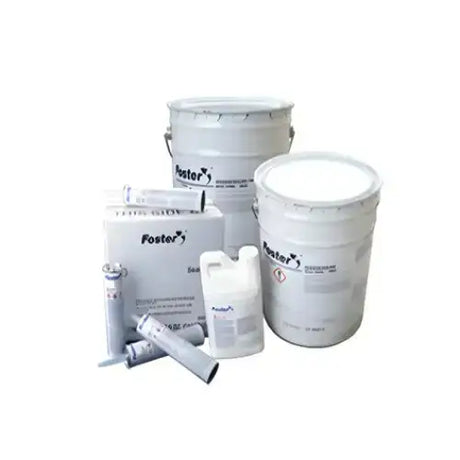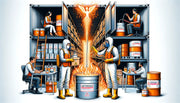Have you ever wondered what keeps your home warm during those chilly winter months or cool during a scorching summer? The answer often lies in the materials used in construction, particularly in their ability to conduct heat. Thermal conductivity is a material's innate ability to transfer heat, and it plays a pivotal role in the efficiency and durability of various building materials, including mastics. In this article, we'll unravel the intricacies of thermal conductivity within the realm of mastics, exploring why it's such a critical feature and how it's applied in the real world. So, buckle up as we embark on a journey through the fascinating world of thermal conductivity!
What are Mastics?
Definition and Composition
Mastics—the term might sound exotic, but it's a commonplace material found in various applications around us. Essentially, mastics are a type of viscous material used as an adhesive, sealant, or coating. Composed of organic compounds such as bitumen, resins, and rubber, they can also contain inorganic materials like fiberglass or mineral fillers which enhance their properties.
Types of Mastics
There's a plethora of mastics out there, each tailored for specific uses. You've got the high-temperature mastics which can withstand extreme heat, perfect for industrial ovens and furnaces. Then there are the waterproofing sealants, designed to keep the moisture at bay, crucial for maintaining the integrity of buildings. Other types include fire-resistant coverings, which provide an extra layer of safety, and vapour barriers that prevent the passage of moisture through walls.
Common Applications
Mastics are quite the versatile bunch. They're used to seal joints and cracks, bind materials together, and provide insulation. Whether it's in the construction of skyscrapers, the automotive industry, or even aerospace, mastics are a hidden yet integral component that ensures longevity and safety.
Importance of Thermal Conductivity in Mastics
Role in Performance
Why bother about thermal conductivity when it comes to mastics? Well, imagine slathering a sealant around a pipe, only to find out it can't handle the heat and starts to degrade—hardly ideal, right? The ability of mastics to conduct heat determines their suitability in various situations, especially in environments that face temperature extremes.
Impact on Durability and Efficiency
It's simple: if a mastic can't stand the heat, it won't stay in the kitchen—or any other place for that matter. Thermal conductivity affects how long a mastic will last and how well it will perform its intended function. A sealant that can effectively transfer heat will be less prone to thermal damage, and in turn, more durable.
Real-Life Applications
Take a stroll through a hospital, and you'll find mastics at work in the ventilation systems, ensuring that everything runs smoothly and safely. Or consider electronic devices; mastics are there too, providing thermal management that keeps your gadgets from overheating. It's the unsung hero of material properties.
Factors Affecting Thermal Conductivity
Composition and Materials
Not all mastics are created equal. The inclusion of fiberglass or ceramic microspheres, for instance, can significantly alter thermal conductivity. The choice and combination of materials in a mastic's composition dictate its ability to conduct heat.
Density and Porosity
It's a bit like a sponge; the more porous it is, the less dense, and the less heat it will transfer. A denser mastic will usually have a higher thermal conductivity because there's more material to facilitate heat transfer.
Temperature and Environmental Conditions
It's not just about the mastic itself; external factors play a role too. The surrounding temperature and environmental conditions can affect how well a mastic conducts heat. For example, a mastic that performs well in temperate climates might not hold up in the scorching heat of a desert.
Measurement and Testing of Thermal Conductivity
Standard Methods
To measure thermal conductivity, professionals use established methods like the steady-state or transient line source techniques. Precise measurement is crucial—it's the difference between a building that stands the test of time and one that doesn't.
Importance of Accurate Measurement
Getting the measurement right is essential for choosing the correct mastic for the job. If a sealant's thermal conductivity is overestimated, it could lead to overheating and failure. Conversely, underestimate it, and you might be missing out on energy efficiency.
Challenges in Measurement
Measuring the thermal conductivity of mastics is no walk in the park. There are challenges, such as accounting for the effects of aging on the mastic or ensuring that the test conditions reflect the real-world application. It's a delicate balance between theory and practice.
Understanding Thermal Insulation Properties
Relationship Between Conductivity and Insulation
Here's an interesting tidbit: while we often want mastics to conduct heat, sometimes we want the exact opposite. Insulation effectiveness is inversely related to thermal conductivity. The lower the conductivity, the better the insulation. It's a yin and yang scenario where both properties are valuable in their own right.
Importance in Different Applications
In the depths of winter, thermal insulation mastics can be the barrier that keeps the cold out and the warmth in, saving on heating bills. On a hot summer day, they do the reverse, keeping spaces cool. The right mastic can make all the difference in the comfort and energy efficiency of a building.
Role in Thermal Barrier Systems
In the grand scheme of things, mastics play their part in thermal barrier systems, working alongside other materials to manage heat flow. They help maintain desired temperatures, be it in a residential home or on the spacecraft hurtling through the cold vacuum of space.
Enhancing Thermal Conductivity in Mastics
Innovations and Advancements
The quest to improve thermal conductivity in mastics is ongoing. Researchers and manufacturers are constantly innovating, looking for that breakthrough that will lead to better performance. From nanotechnology to hybrid materials, the future of mastics is looking hot—figuratively speaking, of course.
Impact of Additives and Fillers
Additives and fillers can turn an average mastic into a super-performer. Materials like aluminium oxide or boron nitride can enhance thermal conductivity, enabling mastics to be used in more demanding applications. It's a bit like a chef fine-tuning a recipe for the perfect dish.
Case Studies or Examples
Consider the case of industrial ovens, where high-temperature mastics have been improved to withstand greater heat while maintaining structural integrity. Or the development of mastics for use in electric vehicle batteries, where effective heat management is vital for safety and performance. These real-world advancements are testaments to the evolution of mastics in the heat of the moment.
Applications of Mastics with High Thermal Conductivity
Industries Where High Thermal Conductivity is Crucial
In industries where temperature extremes are the norm, a mastic's ability to handle heat can be make-or-break. High thermal conductivity mastics are indispensable in the manufacturing, energy, and aerospace sectors, to name a few. They ensure that machinery, equipment, and structures can withstand and manage heat effectively.
Key Applications
Take the energy sector for example, where mastics are used in the insulation of steam pipes. These mastics must ferry heat efficiently to prevent energy loss. In electronics, high thermal conductivity mastics aid in dissipating heat from components, safeguarding against overheating and potential failures.
Challenges and Limitations
Achieving Desired Thermal Conductivity
It's not always straightforward to achieve the desired thermal conductivity in a mastic. Formulating a product that ticks all the boxes - durability, cost-effectiveness, and performance under various conditions - is a tall order. It requires a fine balance and often, a touch of ingenuity.
Limitations of Technologies and Materials
While we've made leaps and bounds in material science, we're still bound by the limitations of current technologies and materials. Some high-performance additives may be too costly for widespread use, or they might introduce other issues, such as reduced flexibility or increased curing time.
Future Prospects
Despite these challenges, the future looks bright. Research is ongoing to find more efficient ways to enhance thermal conductivity without compromising other properties. It's a journey of discovery, with each new development moving us closer to the ideal balance.
Regulatory Standards and Compliance
Standards and Regulations
When it comes to materials used in construction and manufacturing, there's a labyrinth of standards and regulations to navigate. These ensure that products meet safety and performance benchmarks. Mastics with specific thermal conductivity properties are no exception and must align with these stringent requirements.
Importance of Compliance
Compliance isn't just about ticking boxes; it's about consumer safety and confidence in the products used. For manufacturers, compliance can be the gateway to market access and the foundation of a trusted brand reputation.
Impact on Development and Use
Regulatory requirements can shape the development and use of mastics. They can drive innovation as manufacturers strive to meet or exceed these standards. In the end, it's a push and pull between regulation and innovation that drives the industry forward.
Environmental and Sustainability Considerations
Energy Efficiency Impact
In a world increasingly conscious of energy consumption and its environmental impact, the role of mastics cannot be understated. Thermal conductivity in mastics can lead to improved energy efficiency, as they help regulate temperature and reduce the need for excess heating or cooling.
Sustainable and Eco-Friendly Practices
The construction industry is moving towards more sustainable practices, and mastics are part of this green revolution. By using mastics that contribute to better insulation and tighter seals, buildings have a smaller carbon footprint.
Developing Environmentally Responsible Mastics
Mastic manufacturers are also embracing the trend towards environmentally friendly products. This includes not just the performance of the mastic but also its lifecycle—from production to disposal. Innovations in this space are leading to mastics that are not only efficient but also kinder to our planet.
Case Studies and Practical Examples
Success Stories
Real-world examples abound of mastics delivering on their thermal conductivity promises. In the refurbishment of historical buildings, for instance, modern mastics are used to improve insulation without compromising the structure's integrity. Or consider their use in solar panels, where they help manage the heat generated, thereby improving efficiency and lifespan.
Lessons from Different Industries
Each industry presents a unique set of challenges and requirements, and mastics have had to adapt accordingly. The automotive industry, for example, has seen the development of mastics that can withstand the rigors of high temperatures and mechanical stress. The aerospace industry requires mastics that can cope not just with heat but also with the vacuum of space and radiation.
Insights for Professionals
For professionals in the field, these case studies are a goldmine. They offer practical insights into what works, how to apply mastics correctly, and what considerations must be taken into account when selecting a mastic for a particular application.
Conclusion
Thermal conductivity in mastics is a subject as deep as it is wide, serving as the invisible foundation upon which the reliability and efficiency of many systems rest. From the humble home to the reaches of outer space, mastics play a crucial role. For industry professionals and stakeholders, understanding the nuances of thermal conductivity in mastics is essential for making informed decisions that will stand the test of time and temperature. As we look to the future, the blend of regulation, innovation, and environmental consideration will continue to shape the development and application of these versatile materials. The thermal conductivity of mastics is more than just a technical detail; it's a significant factor in the sustainability and safety of our constructed environments.
































































